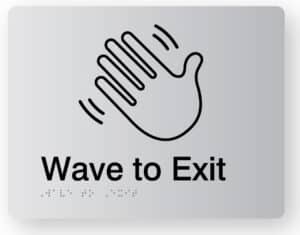We are now regularly seeing the installation of ‘Wave to Open and Wave to Lock’ buttons used on automated doors, including entrance doors, specialised spaces, and doors to accessible toilets. I am seriously concerned about the use of such controls that seemed to appear around the time of the COVID hysteria.
The irony is you do not want people touching a traditional button, but it is fine to touch everything else in an accessible toilet, or the door handles, kitchen appliances, etc, that you come into contact with every day.
This type of door control, in my opinion, discriminates against people with vision impairment and also people who have an intellectual disability or are Culturally and Linguistically Diverse (CALD), especially those for whom English is not their first language. Will they be able to comprehend what is required?
How do you explain what ‘wave’ means to a person with vision impairment? Is it a big wave, a little wave, a side-to-side wave or even a Queen Elizabeth type wave? Then, think about how someone with vision impairment will know where to wave and for how long.

My preference would be to see the return of the mushroom buttons that can be felt by someone with vision impairment and, importantly, needs to be pushed. People don’t want to touch a button to open a door but will then grab a door handle on the next door they want to go into.
‘AS 1428.1:2009 Design for Access and Mobility. Part 1: General requirements for access—New building work‘ clause 13.5.4 that states:
13.5.4 Power-operated door controls
Push-button controls shall have a minimum dimension of 25 mm diameter and be proud of the surface and shall activate the door before the button becomes level with the surrounding surface.
As the ‘Wave to’ buttons do not meet this prescriptive requirement, a performance solution needs to be prepared to demonstrate compliance with the performance requirements. However, a performance solution must demonstrate that it is equal to or better than the minimum deemed-to-satisfy requirements, which, in this case, they do not. They make accessibility worse for people with vision impairment.
Has any building surveyor or certifier requested a performance solution to vary this prescriptive requirement as there is a risk of entrapment?
We need to revisit old-school push buttons and stop trying to solve a problem that does not exist, as it creates more barriers for people with disability and stick with buttons.